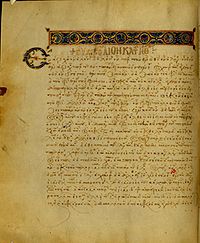New Testament manuscript
| New Testament manuscript | |
 The first page of Matthew The first page of Matthew | |
| Text | New Testament (except Rev.) |
|---|---|
| Date | 12th century |
| Script | Greek |
| Now at | Magdalen College |
| Size | 22.5 cm by 19 cm |
| Type | Byzantine text-type |
| Category | V |
| Hand | beautifully written |
| Note | marginalia |
Minuscule 57 (in the Gregory-Aland numbering of New Testament manuscripts), δ 255 (in the Von Soden numbering of New Testament manuscripts), Rahlfs number 69 (in the Rahlfs numbering of Greek Septuagint manuscripts), is a Greek minuscule manuscript of the New Testament and the Psalms, written on parchment. Using the study of comparative writing styles (palaeography), it has been assigned to the 12th century. The manuscript is lacunose. It has marginalia.
Description
The manuscript is a codex (precursor to the modern book) containing the entirety of the New Testament except the Book of Revelation, on 291 parchment leaves (size 22.5 cm × 19 cm (8.9 in × 7.5 in)), with two gaps (Mark 1:1-11 and at the end). The leaves are arranged in quarto (four leaves in quire) form. The text is written in one column per page, 25 lines per page. The Psalms and Hymns follow the Epistles. The initial letters and headpieces are illuminated. It has accents and breathings, and contains the nomina sacra (special names/words considered sacred in Christianity - usually the first and last letters of the name/word in question are written, followed by an overline; sometimes other letters from within the word are used as well) throughout. The initial letters are in gold. According to Biblical scholar Frederick H. A. Scrivener, it is written in small, beautiful letters with abbreviations, a sentiment also echoed by biblical scholar Orlando Dobbin, who describes the letters as "exquisite, very small, marked by a perfect uniformity, and full of rather puzzling but symmetrical flourishes and contractions."
It contains the tables of contents (known as κεφαλαια / kephalaia) before the Gospels of Matthew, Luke, and John (and likely also before the Gospel of Mark, but the leaves are missing). The text is divided according to the chapters (also known as κεφαλαια), whose numbers are given in the margin, and their titles (known as τιτλοι / titloi) at the top of the pages. It contains lectionary markings in the margin (used to assist with finding the correct reading on a Sunday during the church calendar), written in red ink (for liturgical use), but added by a later hand.
The manuscript is arranged in the following order:
- κεφαλαια to Matthew
- Gospel of Matthew
- Gospel of Mark
- κεφαλαια to Luke
- Gospel of Luke
- κεφαλαια to John
- Gospel of John
- Acts of the Apostles
- The Seven Catholic Epistles
- The Epistles of Paul with Hebrews
- The Psalms
- Hymns from the Old and New Testament
Text
The Greek text of the codex is considered a representative of the Byzantine text-type. The text-types are groups of different New Testament manuscripts which share specific or generally related readings, which then differ from each other group, and thus the conflicting readings can separate out the groups. These are then used to determine the original text as published; there are three main groups with names: Alexandrian, Western, and Byzantine. Textual critic Kurt Aland placed it in Category V of his New Testament manuscript classification system. Category V is for "Manuscripts with a purely or predominantly Byzantine text."
It was not examined using the Claremont Profile Method.
History

The manuscript was likely written in Constantinople, in the 3rd quarter of the 12th century, with additions up to the end of the 14th century including a note relating to Epeiros.
Bishop Brian Walton used it for a Polyglot (as Magd. 1). Henry Hammond collated the manuscript twice. It was also examined by textual critic Johann Jakob Wettstein in 1715, Dobbin (for theologian John Mill), and biblical scholar Caspar René Gregory saw it in 1883.
It is currently housed in the Magdalen College (shelf number Gr. 9), at Oxford in England.
See also
References
- Gregory, Caspar René (1908). Die griechischen Handschriften des Neuen Testament. Leipzig: J. C. Hinrichs. p. 50.
- ^ K. Aland, M. Welte, B. Köster, K. Junack, "Kurzgefasste Liste der griechischen Handschriften des Neues Testaments", Walter de Gruyter, Berlin, New York 1994, p. 50.
- ^ Gregory, Caspar René (1900). Textkritik des Neuen Testaments. Vol. 1. Leipzig: J.C. Hinrichs. pp. 141–142.
- ^ Scrivener, Frederick Henry Ambrose; Edward Miller (1894). A Plain Introduction to the Criticism of the New Testament. Vol. 1 (4 ed.). London: George Bell & Sons. p. 198.
- ^ Dobbin, Orland T. (1854). The Codex Montfortianus: A Collation. London: Samuel Bagster & Sons. pp. 28–29.
- Metzger, Bruce Manning; Ehrman, Bart D. (2005). The Text of the New Testament: Its Transmission, Corruption and Restoration (4th ed.). Oxford: Oxford University Press. pp. 205–230. ISBN 0-19-516667-1.
- ^ Aland, Kurt; Aland, Barbara (1995). The Text of the New Testament: An Introduction to the Critical Editions and to the Theory and Practice of Modern Textual Criticism. Erroll F. Rhodes (trans.). Grand Rapids: William B. Eerdmans Publishing Company. p. 138. ISBN 978-0-8028-4098-1.
- Wisse, Frederik (1982). The Profile Method for the Classification and Evaluation of Manuscript Evidence, as Applied to the Continuous Greek Text of the Gospel of Luke. Grand Rapids: William B. Eerdmans Publishing Company. p. 54. ISBN 0-8028-1918-4.
- Magdalen College MS. Gr. 9
- Wettstein, Johann Jakob (1751). Novum Testamentum Graecum editionis receptae cum lectionibus variantibus codicum manuscripts. Amsterdam: Ex Officina Dommeriana. p. 51.
External links
- Minuscule 57. Entry in the Manuscript Database of the Göttinger Septuaginta by Georgi Parpulov, published 28 March 2023
- Minuscule 57 at Oxford University
- Online images of Minuscule 57 at the CSNTM.